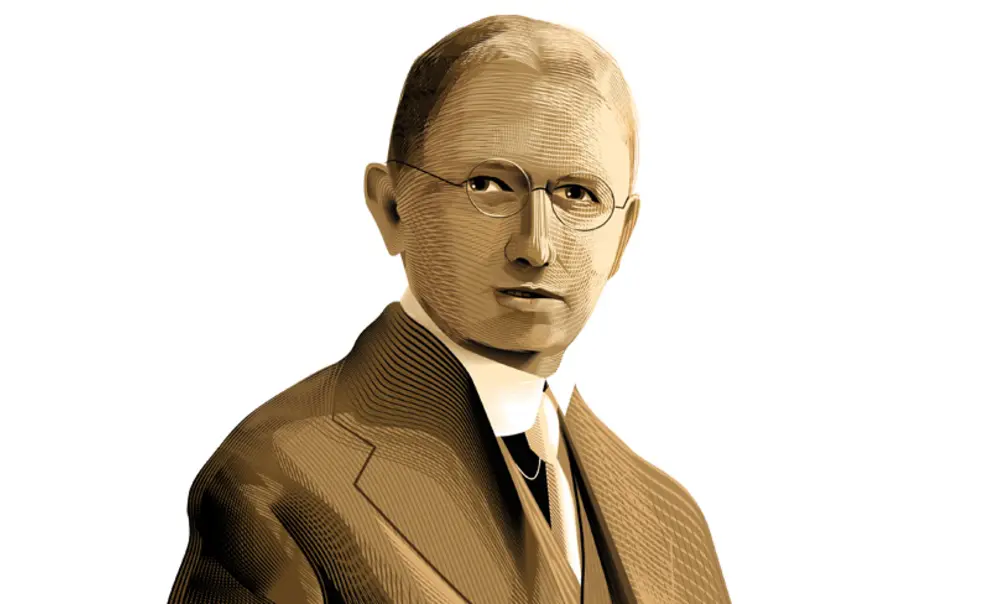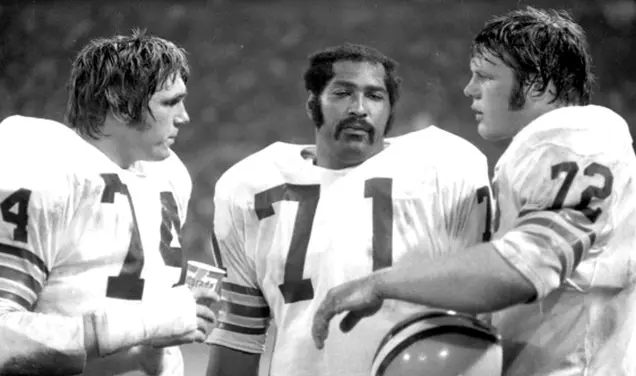A Stellar Student, He Transformed Our Understanding of the Stars
Henry Norris Russell 1897 *1900
“There was a time when it was supposed to be beyond human power to find out what the sun and stars were made of,” wrote Princeton astronomer Henry Norris Russell 1897 *1900 in a 1941 issue of Scientific American, for which he wrote a monthly column for more than 40 years chronicling advances in the study of the cosmos. “We all know how the ‘hopeless’ problem was suddenly solved.”
Russell knew the solution because he had played a critical part in determining the sun’s composition using the discipline of spectroscopy, the study of the interaction between matter and electromagnetic radiation. Because each element gives off its own configuration of wavelengths in the form of solar radiation, if astronomers could record the spectrum emitted by the sun, they could determine its composition. Among his many astronomical innovations, in 1929, Russell proved that the sun was mostly made up of hydrogen, a revelation that informed the later determination that the element was the building block of much of the known universe.
By comparison, Russell’s universe started out small within a family of vast intellectual horizons. Growing up in the affluent Long Island community of Oyster Bay, his father was a minister whose congregation included future president Theodore Roosevelt. Despite his spiritual upbringing, Russell came from a mathematical family — his grandmother had won an award for her mathematics prowess at Rutgers Female Institute in New York, and his mother had been recognized for her math ability at the University of Edinburgh.
In 1882, when Russell was 5 years old, his parents showed him the transit of Venus, an influential moment that informed his interests going forward. Sensing his potential, his parents enrolled him in Princeton Preparatory School. While attending, he lived with his aunt Ada Norris in her house at 79 Alexander St., a home he would eventually inherit and inhabit for the rest of his life.
Entering the University in 1893, Russell developed a passion for astronomy under the magnetic professor Cyrus Young. A workaholic, Russell didn’t play cards, smoke, or drink beer as a student. He graduated with the rare distinction of insigni cum laude (with extraordinary honor), and his class yearbook dubbed him “Our Bright and Shining Star.”
However, after receiving his Princeton doctorate in astronomy in 1900, Russell’s overwork caught up with him and he suffered a nervous breakdown. Sent to the Italian island of Capri to recover, he went on to pursue postdoctoral work at the University of Cambridge. He returned to Princeton in 1905 to join the faculty; six years later, he was appointed director of the Princeton observatory, where he’d stay on until his 1947 retirement.
As an instructor, Russell was enthusiastic and erratic. According to biographer David DeVorkin, Russell’s lectures frequently exceeded the class window by hours, during which he would fiddle with his chair nonstop. “Russell would stumble over it, climb on it, [and] declaim for a minute or so from the summit,” wrote former student Donald Menzel *1924.
The field of astronomy was transitioning from strict observation of celestial objects toward astrophysics, paving the way for the physical and chemical understanding of celestial movements and processes. Starting in 1921, Russell split his time between Princeton and the Mount Wilson Observatory in Southern California. According to DeVorkin, he was recruited to “serve as an interpreter and as catalyst” between physicists at Caltech and the astronomers atop the mountain, enabling better collaboration between the theorists and the observers.
Through his regular columns in Scientific American, Russell also represented an antecedent of popular science communicators like Neil deGrasse Tyson, chronicling the rapid leaps astronomy made in the first half of the 20th century.
Upon the discovery of the first planets outside our solar system in 1943, Russell wrote that “this latest discovery completes the work which Copernicus began four centuries ago,” explaining that the idea that the Earth was at the center of the universe was now long dead. “There is no longer a basis for supposing that either this world or its inhabitants are unique,” Russell wrote. “The realization of this should be good for us.”











6 Responses
Thomas Zaslavsky *65
1 Week AgoSignificance of the Hertzsprung-Russell Diagram
I enjoyed the short PAW article and decided to look up this astronomer, to me unknown, in Wikipedia. As soon as I read “Hertzsprung-Russell diagram” I realized how famous and important he was and that I’ve known about him for decades. Even I, a mere follower of astronomy, know this diagram, which is fundamental for stellar astronomy.
It’s too bad that your nice article about Russell omitted his possibly most important and well-known astronomical achievement. In Wikipedia it is the first achievement mentioned. Maybe you could add a footnote?
Editor’s note: Read more about the Hertzsprung-Russell diagram on Wikipedia and in “Sequencing the Stars” by Princeton emeritus professor Robert J. Vanderbei.
Kathy Whitney Barr
2 Weeks AgoOn Scientists and Spirituality
“Despite his spiritual upbringing, Russell came from a mathematical family,” writes Harrison Blackman ’17 about in the Princeton Portrait about astronomer and astrophysicist Henry Norris Russell.
Many of the great mathematicians and physicists in history were devout. One of the greatest mathematicians of all time, Augustin-Louis Cauchy (1789-1857), wrote, “I am a Christian, that is to say, I believe in the divinity of Jesus Christ as did Tycho Brahe, Copernicus, Descartes, Newton, Fermat, Leibniz, Pascal, Grimaldi, Euler, Guldin, Boscovich, Gerdil; as did all the great astronomers, physicists, and geometricians of past ages.”
One could add to that list many more recent names, such as Fr. Angelo Secchi, one of the founders of astrophysics; Fr. Georges Lemaȋtre, founder of the Big Bang theory; and Kurt Gödel, whose work in mathematics was epoch-making (and who spent most of his career in Princeton).
W. Bruce Hawkins *54
2 Weeks AgoThe Brilliant Thesis of Cecilia Payne
The November portrait of Henry Norris Russell incorrectly describes him as having demonstrated that “the sun was mostly made up of hydrogen.” In fact, he discouraged Cecilia Payne (later Payne-Gaposchkin) from making that claim in her dissertation. Unfortunately, the astronomical community for years remembered his retraction four years later more than her thesis, although he did give her credit at that time. Forty years later, Otto Struve described her work as “the most brilliant Ph.D. thesis ever written in astronomy.”
Don McCarthy ’70
3 Weeks AgoCredit Where Credit Is Due
The Princeton Portrait of astronomer Henry Norris Russell 1897 *1900 (November issue) provides interesting insights into his distinguished career and personality. Indeed, Dr. Russell is immortalized in the famous Hertzsprung-Russell Diagram (aka, H-R Diagram) that continues to revolutionize astrophysics.
Surprisingly however, the article errs in attributing to Russell the discovery that all stars are composed primarily (~99%) of hydrogen and helium. Credit for that fundamental insight belongs to Dr. Ceclia Payne-Gaposchkin in her Ph.D. thesis (1925) at Harvard College Observatory. Her conclusion was so revolutionary that Dr. Russell called it “clearly impossible.” Yet, her discovery was correct and, ironically, received the prestigious Henry Norris Russell Prize in 1976, from the American Astronomical Society.
David Derbes ’74
1 Month AgoBrilliant Women Helped Lay the Foundation of Astrophysics
I enjoyed the Princeton Portrait in November’s PAW on the celebrated astronomer and astrophysicist Henry Norris Russell. But I wanted to put in a corrective note about his determination of stellar composition. The story is a little more tangled.
The first person to advance the idea (which her research had established) that hydrogen was the dominant material in stars was Cecilia Payne, a Cambridge-educated British astronomer who came to the other Cambridge to earn a Ph.D. in astronomy at Radcliffe, as the original Cambridge at the time would not afford her the opportunity.
Russell, though at Princeton, was asked to be on her thesis committee. By many accounts, Russell cautioned her from claiming hydrogen as the dominant material in stars, as this was contrary to then-current wisdom. So she soft-pedaled the claim, even suggesting that her own data had to be wrong. Russell’s criticism may have been meant kindly, to keep her thesis from being rejected; it’s hard to know. Four years later he arrived at exactly the same conclusion and acknowledged her earlier claim in print. However, this did not prevent future writers from assigning credit to Russell alone for the discovery.
Some eight years after her doctorate, Dr. Payne met and married a Russian astronomer, Sergei I. Gaposchkin, and is usually known today as Cecilia Payne-Gaposchkin. She eventually became a professor at Harvard, much with the support of Russell’s student Donald H. Menzel (Princeton *1924), who was tenured at Harvard.
Russell is perhaps better known as a co-discoverer, with Ejnar Hertzsprung, of the Hertzsprung-Russell diagram linking luminosities to temperatures. This diagram too is based heavily on the work of a woman astronomer at Harvard, Annie Jump Cannon, who had categorized stars according to a color scale which became standard.
These and many other stories are told by Dava Sobel in her history The Glass Universe.
Despite my loyalty to Princeton, I admire Harvard Observatory director Edward C. Pickering’s foresight to employ dozens of brilliant, highly educated women in what many would have found mindless toil. These women, not nearly as well-known as they should be, founded astrophysics. To this day, in my opinion, the least sexist branch of physics remains astrophysics, maybe because the sky is open to all. Happily, things are changing, and the rest of physics is making slow but steady progress toward equality.
Mordecai-Mark Mac Low ’83
1 Month AgoRecognizing Cecilia Payne-Gaposchkin’s Pioneering Work
This article erases the contribution of Cecilia Payne (later Payne-Gaposchkin) who in her 1925 Ph.D. thesis at Harvard had already demonstrated that the sun is primarily made of hydrogen. Russell was initially highly skeptical of her result and, as a reviewer of her thesis, forced her to claim that it was likely incorrect. It took him four years to accept it in the work described here, which was then generally accepted. Though he credited Payne, her pioneering work was only widely acknowledged decades later (and apparently still not completely, judging by this article). Payne-Gaposchkin later went on to be the first woman tenured at Harvard, as well as their first female department chair.
I further note that the apparent discovery of planets (or at least brown dwarfs) outside the solar system in 1943 were definitively refuted (though not until the late 1970s), with the first brown dwarfs and planets not being confirmed until a half century later, in the mid-1990s. Russell’s philosophical comments illustrate the danger that every popularizer faces, of deciding when the evidence for an exciting result is strong enough to publicize it.